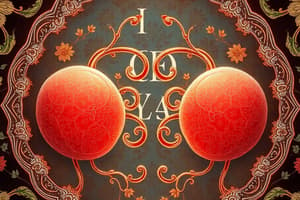Podcast
Questions and Answers
Homologous chromosomes have the same length, centromere position, and gene carried.
Homologous chromosomes have the same length, centromere position, and gene carried.
False (B)
A karyotype is a micrograph of chromosomes arranged in decreasing size during prophase of mitosis.
A karyotype is a micrograph of chromosomes arranged in decreasing size during prophase of mitosis.
False (B)
Humans have 23 pairs of chromosomes, with each pair consisting of two homologous chromosomes.
Humans have 23 pairs of chromosomes, with each pair consisting of two homologous chromosomes.
True (A)
Genes on chromosomes code for the formation of carbohydrates, which carry out most of the work of cells.
Genes on chromosomes code for the formation of carbohydrates, which carry out most of the work of cells.
Signup and view all the answers
Staining bands on chromosomes during metaphase identify identical places on homologous chromosomes, allowing scientists to study whole chromosomes.
Staining bands on chromosomes during metaphase identify identical places on homologous chromosomes, allowing scientists to study whole chromosomes.
Signup and view all the answers
Crossing over occurs during prophase I of meiosis.
Crossing over occurs during prophase I of meiosis.
Signup and view all the answers
During anaphase I, sister chromatids separate and move to opposite poles of the cell.
During anaphase I, sister chromatids separate and move to opposite poles of the cell.
Signup and view all the answers
Meiosis II results in the formation of four haploid daughter cells.
Meiosis II results in the formation of four haploid daughter cells.
Signup and view all the answers
A diploid cell has only one set of chromosomes.
A diploid cell has only one set of chromosomes.
Signup and view all the answers
The process of independent assortment occurs in metaphase II of meiosis.
The process of independent assortment occurs in metaphase II of meiosis.
Signup and view all the answers
Meiosis is a type of cell division that increases the number of chromosomes.
Meiosis is a type of cell division that increases the number of chromosomes.
Signup and view all the answers
During telophase I, the cytoplasm divides to form two daughter cells.
During telophase I, the cytoplasm divides to form two daughter cells.
Signup and view all the answers
Gametes are diploid cells.
Gametes are diploid cells.
Signup and view all the answers
Nondisjunction only happens during meiosis.
Nondisjunction only happens during meiosis.
Signup and view all the answers
Trisomy 21 is a result of nondisjunction.
Trisomy 21 is a result of nondisjunction.
Signup and view all the answers
Autosomes are the sex chromosomes.
Autosomes are the sex chromosomes.
Signup and view all the answers
During meiosis I, homologous chromosomes separate.
During meiosis I, homologous chromosomes separate.
Signup and view all the answers
During meiosis II, sister chromatids separate.
During meiosis II, sister chromatids separate.
Signup and view all the answers
Telophase II involves the chromosomes condensing.
Telophase II involves the chromosomes condensing.
Signup and view all the answers
A human karyotype with 47 chromosomes would be considered a monosomy.
A human karyotype with 47 chromosomes would be considered a monosomy.
Signup and view all the answers
Homologous chromosomes have the same length.
Homologous chromosomes have the same length.
Signup and view all the answers
Study Notes
Meiosis and Sexual Reproduction
-
Meiosis is a type of cell division reducing the number of chromosomes. It forms gametes (sex cells) in sexually reproducing organisms.
-
Homologous chromosomes are chromosome pairs, one from each parent, with similar structure and corresponding genes.
-
Human body cells have 46 chromosomes, 23 pairs.
-
Haploid cells have one set of chromosomes (23 in humans). Gametes are haploid.
-
Diploid cells have two sets of chromosomes (46 in humans). Somatic cells are diploid.
-
Sexual reproduction involves the fusion of male and female gametes (sperm and egg) to form a zygote, which develops into a new organism.
-
Asexual reproduction requires only one parent and creates offspring genetically identical to the parent.
-
Sex determination in humans depends on the sex chromosomes (XX for female, XY for male).
-
Karyotypes are visual representations of an individual's chromosomes arranged in pairs by size.
Nondisjunction
-
Nondisjunction is an error in cell division where chromosomes fail to separate properly during meiosis.
-
Nondisjunction can lead to gametes with extra or missing chromosomes, resulting in genetic disorders in offspring.
-
Examples of human disorders caused by nondisjunction:
-
Down syndrome (trisomy 21)
-
Turner syndrome (monosomy X)
-
Mitosis vs. Meiosis
-
Mitosis produces two diploid daughter cells that are genetically identical to the parent cell.
-
Meiosis produces four haploid daughter cells that are genetically different from each other and the parent cell.
Stages of Meiosis
-
Meiosis involves two rounds of division: Meiosis I and Meiosis II
-
Meiosis I separates homologous chromosomes.
-
Meiosis II separates sister chromatids.
-
Crossing over: genetic exchange between non-sister chromatids of homologous chromosomes, creating genetic variation.
-
Independent assortment: random alignment of chromosomes during metaphase I and II, increasing genetic diversity.
Importance of Meiosis
-
Meiosis produces genetic variation by shuffling genetic material and creating unique combinations of alleles.
-
This genetic diversity is crucial for adaptation to changing environments in sexually reproducing organisms.
Studying That Suits You
Use AI to generate personalized quizzes and flashcards to suit your learning preferences.
Related Documents
Description
Test your understanding of meiosis and sexual reproduction with this quiz. It covers key concepts such as chromosome types, gamete formation, and the differences between sexual and asexual reproduction. Explore how genetic information is passed on through generations and the role of karyotypes in sex determination.




